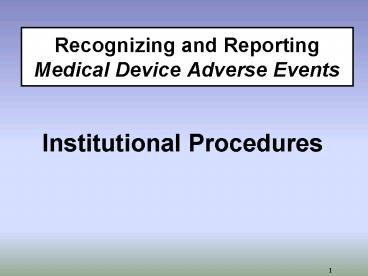Recognizing and Reporting Medical Device Adverse Events - PowerPoint PPT Presentation
1 / 22
Title: Recognizing and Reporting Medical Device Adverse Events
1
Recognizing and ReportingMedical Device Adverse
Events
- Institutional Procedures
2
Reporting Goals
- Patient safety
- Staff safety
- Methods
- Recognizing that an adverse event may be
device-related - Accurate event reporting
- Education
- Improved device design
3
Who Is a Patient
- Any individual who is being diagnosed or treated
and/or is receiving medical care under the
control or authority of the facility, including
employees of or individuals affiliated with the
facility who are injured while working.
4
Who Reports?
- All staff involved in adverse events
- All shifts at all facility locations
- Staff are at the front line of medical
- device incident recognition and
- reporting.
5
What Is a Medical Device?
- Broadly defined
- Anything used in treatment or diagnosis that is
not a drug or biologic (e.g., blood products). - Capital equipment, instruments, implants,
- disposable devices, components, accessories,
reagents, etc.
6
What Is to Be Reported?
- Medical device problems, adverse events,
incidents, and close calls - A significantly problematic, potentially serious,
or injury-causing circumstance experienced with
the operation or processing of a device
(including disposable devices)
7
What Should Be Reported?
- Death
- Serious injury
- Minor Injuries
- Close calls
- Patient and staff adverse events
8
Serious Injury
- An injury or illness that
- Is life-threatening,
- Results in permanent damage to a body structure
or permanent impairment of a body function, or - Necessitates medical or surgical intervention to
preclude permanent damage or impairment.
9
Close Calls
- No injury or illness
- Caught before incident occurred
- Other reports of interest
- Chronic problem with the device
- Poor human factors (usability)
- Work arounds
10
Reporting Focus(See Flowchart Handout Sec 2, p10)
- What devices (including accessory products,
hardware systems, and software) were used on,
attached to, or involved in the care of the
patient at the time of the medical error or
device-related incident?
11
Medical Device Problem Recognition Based on
Patient-Centered Concept
Users Many devices used for diagnosis,
treatment, monitoring, and care
- Accessories/Disposables
- Breathing Circuit
- Heated Humidifier
- Exhalation Filter
- Tracheal Tube
- Water Trap
- Medications
- Reagents
- Solutions
- Dyes
Patient
Medical Devices and Equipment
- User Facility/Home Environment
- Medical Gas
- Electric Power
- Heat, Humidity, Light
- Support Systems
12
Device Interfaces
- Device-User
- Device-Patient
- Device-Accessories (including disposable devices)
- Device-Environment
- Healthcare facility
- Ambulance
- Home
13
Device Interfaces
Environment Hospital/Home
Electric Power Medical Gas Heat, Humidity,
Light
Device
Patient
Ventilator
User
Breathing Circuits Heated Humidifier
Exhalation Filter Water Trap
Accessories/Disposables
14
What Types of Medical Device Problems Do I Look
For?
- Causes or contributing factors
- Look for problems with
- Failures
- Malfunctions
- Poor design
- Manufacturing defects
- Errors in technique of use
- Instructions/labeling
15
What Types of Medical Device Problems Do I Look
For?
- Look for problems with
- Packaging
- Device interactions
- Software problems
- External facilities factors
- (medical gas, vacuum,
- electrical)
16
Immediate Action Plan(See Handout, Sec 2, p12)
- Patient safety addressed first
- Equipment/device damage minimized
- Physicians notified
- Equipment/devices preserved
- Supervisor action to impound
17
Whom to Contact
- Supervisor
- Risk manager
18
Policies and Procedures
- Written medical device adverse event procedures
are required (e.g., JCAHO) - Timely, effective event identification and
communication - Standard review process for reportability
- Timely investigation and development of
preventive strategies - Timely submission of required reports by our
facility
19
Policies and Procedures
- FDA MeDSuN medical device problem reporting
program - Our facility is participating
20
Medical Device Adverse Event Recognition and
Internal Reporting(See Handout Summary, Sec 2,
p14)
- Who?
- What?
- When?
- Where?
- How?
- Why?
- Dos, and Donts
21
Medical Device Adverse Events and Close Calls
Case Reports
Your examples? Which devices involved?
22
Recognizing and ReportingMedical Device Adverse
Events
QUESTIONS?































